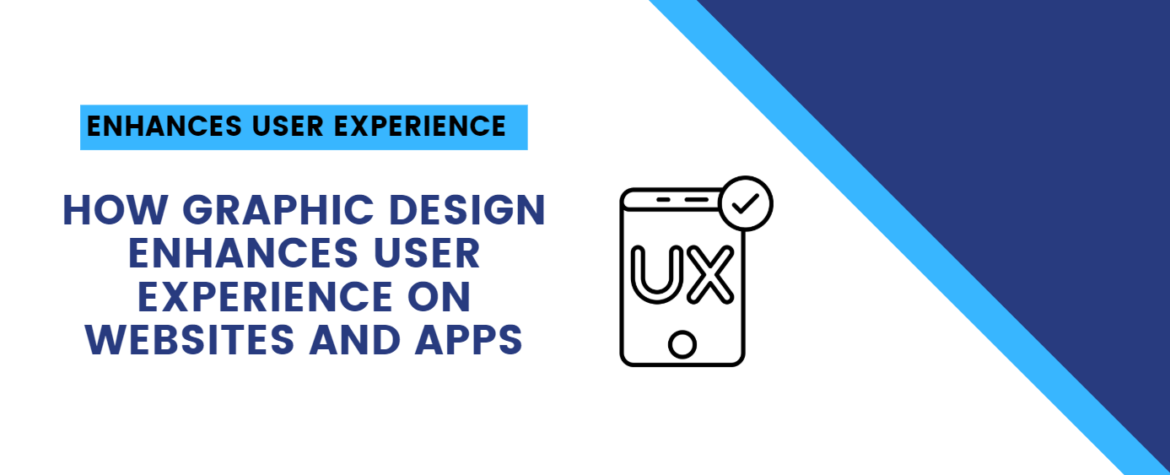In today’s digital landscape, the success of websites and apps doesn’t solely depend on their functionality, but also on how users experience them. A seamless and intuitive user experience (UX) is crucial for keeping visitors engaged and encouraging them to return. This is where graphic design plays a key role. Good graphic design does more than just make things look attractive—it improves usability, guides users through a site or app, and enhances their overall experience.
Let’s explore how graphic design enhances user experience on websites and apps.
1. Creates Clear Visual Hierarchy
Visual hierarchy is all about guiding users through your website or app in a way that feels natural. Graphic design helps establish this hierarchy by using size, color, contrast, and spacing to prioritize important information.
For example, headings might be larger or in bold, while body text is smaller and easier to read. Call-to-action (CTA) buttons, like “Sign Up” or “Shop Now,” are often given a distinctive color to stand out. This intuitive flow helps users quickly find what they’re looking for and know exactly what actions to take, improving navigation and reducing frustration.
In fact, according to a study by the Nielsen Norman Group, users only read about 20% of the text on a page. By applying effective graphic design principles, you can ensure the key messages are highlighted and easy to find, enhancing the user’s ability to navigate and interact.
2. Improves Navigation and Usability
Graphic design plays a crucial role in improving the navigation of a website or app. When menus, icons, buttons, and links are designed clearly and logically, users can easily find their way around without confusion.
For instance, well-designed icons help users understand functions instantly. A shopping cart icon is almost universally understood to represent a cart, and a magnifying glass is commonly used to signify a search bar. By designing intuitive, recognizable icons and navigation elements, graphic designers ensure users can interact with your platform without having to think twice.
According to UX design firm, Toptal, 88% of users are less likely to return to a website after a bad user experience. Clear and effective navigation is essential in providing a positive experience and encouraging users to come back.
3. Boosts Mobile-Friendliness and Responsiveness
With more than half of global web traffic coming from mobile devices, it’s critical that your website or app works well on smartphones and tablets. Graphic design ensures that your platform is responsive, meaning it adjusts seamlessly to different screen sizes and orientations.
Responsive design makes it easier for users to interact with your content, whether they’re using a small smartphone screen or a large desktop monitor. This includes resizing images, adjusting text for readability, and ensuring buttons and menus are touch-friendly. Poor design can make a site or app feel cluttered or frustrating to navigate on mobile, which could cause users to abandon it altogether.
Since mobile-friendliness is also a ranking factor for Google, good graphic design can also improve your site’s SEO performance, increasing visibility and attracting more visitors.
4. Enhances Aesthetic Appeal and Emotional Engagement
First impressions matter. The visual appeal of your website or app has a significant impact on users’ perceptions. If the design is aesthetically pleasing, users are more likely to trust the site and engage with its content. Graphic design helps achieve this by carefully selecting colors, typography, imagery, and layout to create an attractive and cohesive look.
Beyond just being visually appealing, graphic design has the power to evoke emotions. For example, a calm color palette can make users feel relaxed, while vibrant colors can create a sense of excitement. An aesthetically pleasing design engages users emotionally, which can make them more likely to interact with your platform and become repeat visitors or customers.
A study by the Branding Journal found that color increases brand recognition by up to 80%. This shows how crucial design choices like color can play a role in both visual appeal and emotional engagement.
5. Provides Visual Feedback and Enhances Interactivity
Graphic design plays a key role in providing users with visual feedback, which is essential for a positive user experience. For example, when a user clicks a button, changes the state of an item, or submits a form, graphic design ensures that there’s clear visual feedback, such as a button changing color or a confirmation message appearing.
These design elements help users understand that their actions are being recognized, reducing confusion and increasing the sense of control. Interactive elements like hover effects, progress bars, or loading animations also keep users informed, preventing them from feeling lost or unsure about the app’s progress.
According to a study by the Interaction Design Foundation, users are more likely to stay engaged with an app or website when they feel they have clear control over their actions, thanks to consistent visual feedback.
6. Streamlines Content Consumption
Graphic design can help organize and break down content, making it easier for users to digest. Whether it’s through well-structured typography, strategic use of whitespace, or organized layouts, graphic design helps highlight key information and guides users through the content step by step.
For instance, large blocks of text can be overwhelming, but with the right design, they can be broken up into digestible sections, making the content easier to read and comprehend. The use of bullet points, headers, and images can make content more visually appealing and less daunting to read, which can keep users engaged for longer.
Studies show that users spend less than 10 seconds on a webpage before deciding whether to stay or leave. By designing your website or app to present information clearly and concisely, graphic design helps make the most of those precious seconds.
7. Builds Trust and Credibility
A well-designed website or app conveys professionalism and credibility, which is essential for building user trust. When your platform looks polished and cohesive, users are more likely to believe that your business is trustworthy and reliable. On the other hand, a poorly designed website can make users feel uncomfortable or suspicious, causing them to leave.
Good graphic design incorporates elements that establish trust, such as a clean layout, recognizable branding, and clear, easy-to-find contact information. In fact, a study by WebFX found that 38% of users will stop engaging with a website if the content or layout is unattractive.
Conclusion
Graphic design is much more than just creating attractive visuals—it’s a key element in enhancing user experience on websites and apps. By establishing clear visual hierarchy, improving navigation, boosting mobile responsiveness, and creating an emotionally engaging design, graphic design plays a vital role in how users interact with and perceive your platform.
Good design not only makes your website or app look great but also ensures that users have an intuitive, enjoyable experience. Whether it’s through providing visual feedback, enhancing interactivity, or organizing content effectively, graphic design is essential for creating an experience that encourages users to stay longer, engage more, and return in the future.


